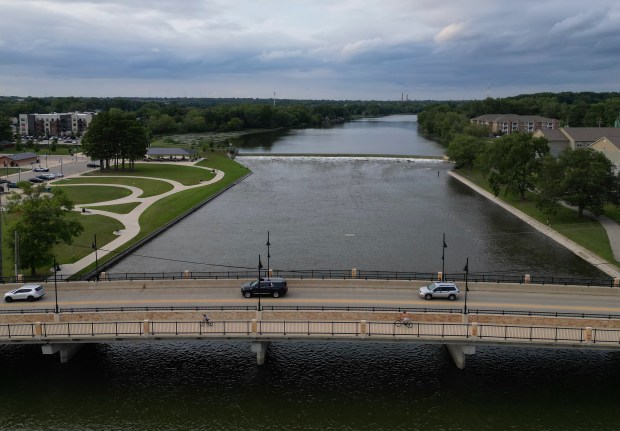Paddling the length of the Fox River, Jenni Kempf was struck by the wildness of it. She marveled at scores of turtles, great blue herons and fish the size of her arm living freely in the morning mist.
“The river stays wild,” she said. “To be able to feel that, of being wildlife myself, is hard to come by.”
On her 200-mile trip in 2022 to promote taking care of the river, Kempf was repeatedly forced to stop and carry her canoe around hazardous dams that halted the flow of water and wildlife.
To improve water quality and habitat by restoring the river of its natural state, while lowering the risk of flooding, the state and the U.S. Army Corps of Engineers have recommended removing nine dams along the Fox River through the far western suburbs.
But residents who want to keep the river the way it is have pushed back against the Army Corps plan. Local officials have raised concerns about how it would affect drinking water, sewage treatment and recreation.
“It’s a terrible thing to be doing,” Geneva resident Steve Bertheau said.
So now the corps has agreed to further study the impacts of dam removal, including how it would affect water levels and what sediments might be released. The environmental analysis will take longer, but the corps is not stopping its program. Officials aim to make a final decision on most of the dams in 2025 and start removal in 2027.
Environmental groups hope the project allows them to realize a decades-long dream, while opponents gear up to preserve what they say is a community asset.
The dams dot the river from Carpentersville to Elgin, South Elgin, St. Charles, Geneva, Batavia, North Aurora, Aurora and Montgomery. Most were built in the 1800s to run flour mills or sawmills that have long since closed. Such low-head dams, which let water flow over the top, create a dangerous backwash that sucks victims underwater, causing drownings and near-fatal accidents.
As a result, the Illinois Department of Natural Resources over recent years has removed about 30 dams on rivers throughout the state, including a dozen on the Des Plaines River. Next, it plans to remove the Carpentersville dam on the Fox River this fall, under a previous agreement with the Kane County Forest Preserve District.
The Army Corps would pay up to 65% of the cost of each dam removal on the Fox, with the rest coming from the state. If municipalities oppose fixes, they would be expected to take over ownership, maintenance and liability for the dams.
The local program is part of a nationwide movement that’s removed some 2,000 dams to restore free-flowing rivers. Studies generally have shown that removing dams improves water quality and increases the number and diversity of fish.
Under a directive from Congress to clean up rivers, the Army Corps examined a range of measures to improve water quality in the Fox River, including rock ramps, bypass channels, partial removals and leaving them as they are. Last year, the corps tentatively recommended the full removal of dams as the only way to improve water quality and restore habitat, while requiring little to no maintenance costs.
Removing the dams is expected to lower water levels significantly. That would likely make parts of the waterway impassible for large motor boats, pitting boaters against kayakers.
Dams in Algonquin and McHenry would remain, keeping the north end of the river and Chain of Lakes intact for power boating.
The lower water levels could significantly affect cities like Aurora and Elgin, which get their drinking water from the Fox River. Officials worry that the shrunken river would force the relocation of their water intake systems, at a cost of millions of dollars.
In response, Elgin is conducting its own studies of the dam and river. Mayor David Kaptain has called for holding a referendum on the question.
“I think people have a right to vote, but I want to be sure people have enough information to make a reasonable decision,” he said. “If we’re going to do this, let’s do it right.”
In Aurora, officials are studying the Army Corps report and seeking more information before deciding next steps.
Among their concerns are the effect dam removal would have on RiverEdge Park, the city’s water intake plant and the planned rehabilitation of the New York Street Bridge.
Recently, a group of residents, Guardians of the Fox River, has sprung up to oppose the plan. It has chapters in South Elgin, St. Charles and Geneva.
Member Marcia Guereca, who lives on the river in South Elgin, says the group fears that dam removal will unleash possibly toxic sediment from a century of human and industrial waste.
Group members note that hundreds of thousands of stocked juvenile salmon died during a large dam removal on the Klamath River in California. The river was filled with sediment, with some deer getting stuck in the mud and having to be euthanized. State officials said the salmon likely died from going through the dam and noted those hydroelectric dams are far bigger than those in Illinois.
Guereca said much of the data the proponents are using is old, noting that the river has been getting cleaner, and that the dams support their own ecosystems, including bald eagles. She worried what will happen to a lowered river when droughts occur, fearing that dried sediment will drift into the air. She argued for preserving the dams, which form gathering places for people as the centerpiece of river towns.
“These are places where people congregate, living together as a community,” she said.
Bertheau, a retired engineer, said the preliminary Army Corps assessment failed to meet basic requirements, and urged local officials not to agree to anything until more analysis is done. He even offered to pay $400,000 to put in stair steps on the Geneva Dam, saying if it saves any lives, it will be well worth it.
In St. Charles, opponents formed the Fox River Preservation Society, which emphasizes that the dams help maintain water flow during droughts, allowing competitive boating, fishing and a thriving ecosystem.
Boating is common in the deeper water created by the St. Charles dam, and the suburb’s park district rents out kayaks and paddle boats, City Administrator Heather McGuire said. A special committee will study what effects dam removal would have, and an engineering consultant will be hired to report on how water levels would be affected.
“Everybody has strong opinions on it,” she said. “It depends on where they fall in terms of the environment versus recreation.”


And in South Elgin, the city centers on the riverfront near the dam, with concerts at Panton Mill Park. Village Administrator Steve Super said officials expect the Army Corps to come back with better public communication and answers for their questions, including concerns about the impact on sanitary sewer plants upriver.
In contrast, in Batavia, where the city owns its dam, City Administrator Laura Newman said officials generally favor removing it. Just last month, police had to rescue a man and his dog from just below the dam. But residents want to preserve a main attraction in their downtown park, a bay beside the dam where people use paddleboats and ice-skate in the winter.
The city’s master plan calls for building a berm to turn the bay into a pond, with pumps to maintain its water level, and a series of successively lower dams known as rock weirs. The cost was estimated years ago at around $22 million.
The dams are favorite fishing spots for anglers. But they typically fish downriver from a dam, where the churn oxygenates the water and attracts fish, not on the upriver side, where stagnant water is low in oxygen and creates algae blooms.
Environmental groups including the Fox River Study Group, Izaak Walton League and Sierra Club argue that dam removal is the best solution for restoring the wildlife of the river and protecting people from tragic drownings.
Friends of the Fox River President Gary Swick says the data showing improved river habitat from dam removal is on their side.
“You can design around most of these challenges,” he said. “You can move on with a healthy river.”
The Army Corps won’t remove dams without the owners’ approval, Chicago District spokesperson Jacob Zdrojewski said, and will hold more public hearings after further study, in the design phase of the project.
The Illinois Department of Natural Resources owns most of the dams, but its officials also say they won’t remove them without local approval, and will pay up to 60% of the cost of removal for other options.
Alternatives to full removal include putting boulders in behind the dams to reduce the backwash effect, letting water flow through a side channel or putting steps on the backside of the dam, which IDNR says reduces but doesn’t eliminate the safety threat.
“Dam removal is the best way to do that, and we’re working with communities who agree with that approach,” IDNR’s Wes Cattoor said. “We’re not here to dictate what occurs, but to find a solution that’s best for everyone.”




